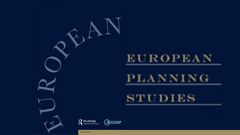Thierstein and Alaily-Mattar, both from our Chair of Urban Development, published two contributions to the special issue of ‘European Planning Studies’.
For nearly as long as there have been urban centres, exceptional architecture projects have contributed to transforming city form and city fortunes. In this special issue of ‘European Planning Studies’, the focus lies on star architecture and its ability to contribute to urban transformation, with articles on the phenomenon of star architecture from a range of disciplines. Star architecture is a topic where concerns about place, identity, economy, innovation and communication intersect. The introduction to the special issue overviews how star architecture participates in urban transformations, and addresses how research into star architecture connects to ideas of identity and branding, the media, the economy, urban governance and architecture itself. It also looks at methodologies for studying star architecture and urban transformation: the choice of research methods and research approach affects the problematization and the types of research questions that can be answered. Studying star architecture offers insight into disparate fields including network analysis, media studies, geography, planning, cultural economy, identity, branding and spectacle. By looking beyond economic effects, researchers can expand the audience for studies of star architecture, and more fully understand its role in urban transformation.
European Planning Studies provides a forum for ideas and information about spatial development processes and policies in Europe. The journal publishes articles of a theoretical, empirical and policy-relevant nature and is particularly concerned to integrate knowledge of processes with practical policy proposals, implementation and evaluation.
European Planning Studies features articles which focus on the functional dimensions of planning, such as infrastructure, communications, environmental quality, design, cultural, social welfare, recreational, housing, industrial and employment concerns of planning at whatever spatial scale. Articles which are concerned with these questions in an appropriate spatial context, given the scope of the journal, are of special interest. The journal also carries European Briefing, Research Briefing and Book Reviews sections.
It is published in cooperation with the Association of European Schools of Planning (AESOP), an independent body of professional planning educators with a membership of over 100 planning schools throughout Western and Eastern Europe.
